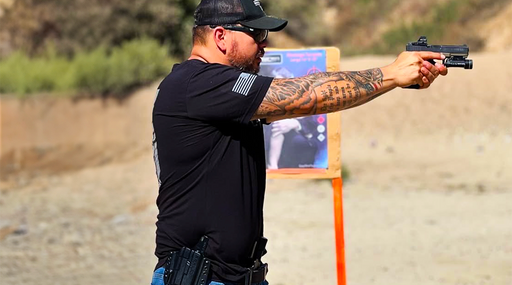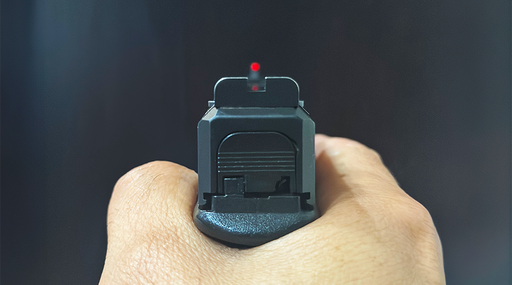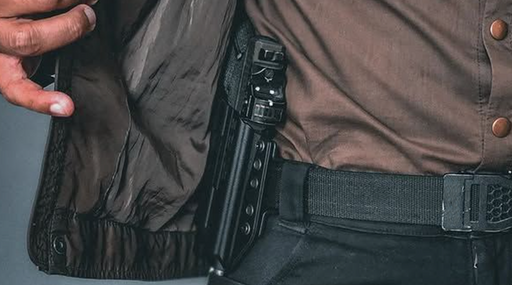Gripping the handgun well is essential to good shooting and even injury prevention. A correct grip maximizes control over the gun, both in terms of recoil management and the potential for it to be wrested from the lawful user’s hands in a violent situation. Good grip technique also prevents burns, pinches, and lacerations by keeping hands clear of the places where action takes place during the firing sequence.
Lots of people have shared with me that they own a gun because they received it as a gift or inheritance but avoid touching it because they feel like it might hurt them. A healthy respect for what a gun can do is a wise thing! However, it’s impossible to become a safe gun handler unless one actually practices the physical handling of a gun. That takes a little time and discipline to interact with the gun on a regular basis. For those new to guns, I recommend checking out an earlier article on basic gun handling. Then, revisit this article, which addresses how to grip a gun correctly once you understand how to control the direction of the muzzle and keep your fingers outside and away from the inside of the trigger guard.
Thanks to the propensity of some people on the internet to re-post pictures out of context, there are not photographs here of the most common grip mistakes. Instead, I’ll discuss the technique I use that works for nearly all of today’s striker-fired semi-autos and many hammer-fired semis also. Depending on the gun you’re using, slight variations to thumb placement may be necessary, but the changes are relatively minor except where revolvers or derringers are concerned—and that is a story for another day.
“Spanglish” is a language propensity in my part of the world, and I make regular use of it regarding grip, to help folks remember what hand goes where. That is included in this article. If you take offense to these light-hearted mnemonics, coming from a blue-eyed instructor working with a student population that’s about 70 percent Hispanic, please move on and be grouchy somewhere else.
The primary hand is the one that pulls the trigger. Generally, that’ll be the same hand you write with. Let’s call it Jefe (HEFF-ay), meaning “boss.” Jefe can shoot just fine by him/herself, and in real-life encounters, Jefe often works alone due to time being of the essence.
The grip starts with Jefe picking up the gun so the “V” between the thumb/forefinger is as high up on the backstrap of the gun as possible. This will place the trigger finger along the slide—remember “feel the steel;” credit to Defoor Performance Shooting for that little rhyme. The lower three fingers should stay wrapped firmly, but not so tight as to cause tension, around the grip.
Now we add in the helper—the “other strong hand,” so to speak. Jefe wouldn’t be a boss without an underling, so this second hand we’ll call Segundo, or the dude who plays second fiddle. Segundo’s four fingers should be stacked and touching before heading to the gun. As they approach the gun, Segundo’s index finger slides underneath, but in contact with the trigger guard.
At the same time that Segundo’s four fingers slide under the trigger guard and wrap firmly around Jefe’s fingers, Segundo’s lowest thumb joint is reporting to duty underneath the same joint of Jefe. In this way, the thumbs are positioned like spoons stacked in a drawer—or that nice cuddly sleeping position you might enjoy with your partner. “Spooning” is fun, on a gun or in bed! But I digress. Looking at your own grip, when your lowest thumb joints are cradled like spoons and you’re gripping firmly, there’ll be no pocket of air under the palm of Segundo. Assuming your gun isn’t too big for your hands, there should be no grip visible between your hands. If you look at your grip to discover the heels of your hands are looking like a set of butt cheeks, you’re probably not “spooning” and are giving up some recoil control thanks to the big air pocket that’s under the palm of the support hand. If you’re gripping well, there’ll be no air gap under the palm of Segundo.
The primary index points for the hands, then, are:
1. The “V” of Jefe, the primary hand, as high as it can go on the backstrap.
That’s assuming, again, that the gun is a good fit—on many double action revolvers and semis, many people find that lowering the primary hand about half an inch is the only way to reach and operate the heavy trigger.
2. The index finger of Segundo, the support hand, slides under the trigger guard and stays in contact with it.
With the two-handed grip in place, push the muzzle of the gun toward the target firmly with the Jefe arm. The Jefe fingers are closed firmly, but not tightly. You need enough relaxation in those fingers to press the trigger with feel.
At the same time, Segundo is holding on like the whole Jefe/gun combo are the gate on a corral you’re standing on the outside of, and there’s a wild steer about to attempt to make a breakthrough the inward-swinging gate. Keep that gate closed! Using the pectoral and forearm muscles, Segundo exerts pressure on the gun both toward the other hand and back toward the sternum. When I shoot, my wrists are as locked as I can make them, but not tense. Locked wrist joints are a free malfunction prevention device; use them for all handgun shooting.
Whether the support arm elbow is bent or not depends mostly on my stance. I believe this is immaterial to grip so long as the wrist joints stay locked to provide maximum recoil control and a platform against which the slide can fully cycle after every shot. There are a few reasons why it’s generally best to keep the firing-side elbow straight; arm fully extended—not the least of which is preventing the slide from hitting your pretty face. I say “generally” because certain situations call for exceptions—but a straight firing hand arm is a good starting point and good habit.
Common Grip Habits I Don’t Do, and Why
The grip described above is my basic go-to. There are variations. For example, on most 1911-style handguns, the firing-hand thumb will ride above the thumb safety lever, having disengaged it during the draw stroke. There are a few other common variants. The following aren’t “wrong,” but I generally avoid them.
1. Support hand (Segundo) thumb crossed over primary thumb. This is usually the proper grip for a revolver and was taught as proper when police agencies were moving from revolvers to semiautos—and thus it has persisted as police shooting scholars often become teachers of civilians. We know now it’s best to have as much flesh as possible in contact with the gun for the sake of recoil management. This is accomplished by the grip described earlier. Crossed thumbs aren’t a critical error, but a habit that can get in the way of efficient follow-up shots.
2. Segundo’s index finger on front of the trigger guard. Some trigger guards are shaped as a veritable invitation to anchor the index finger around the front. Nothing wrong with that, however it can create problems for distance shooting. That extended finger almost always influences the muzzle to the right or left in a way the shooter doesn’t intend. The longer the distance between the gun and target, the more error is apparent from that lateral influence on the trigger guard. Another consideration is regarding defensive shooting. An index finger on Segundo, separated from its other three amigos, creates a greater risk of unintentionally slipping that index digit into the trigger guard. The extended support-side index finger is an old trend in competitive shooting that is presently rearing its head again. Some competitors find it useful, ostensibly for recoil control, but they are playing a game that balances rewards for speed and accuracy and in which distance shots are rare or nonexistent. People who carry guns for self-protection or to maintain public safety cannot afford to put speed ahead of accuracy as a habit. Competition can have great value for the daily carry practitioner, but that not all the techniques and gear on the “race” side of the gun world make sense for defensive use.
Common Grip Errors
Even if you saw it on a Hollywood movie, the following errors have no use aside from the comfort of habit for those who use them.
1. “Teacupping” means cupping the firing hand in the palm of the support hand. It’s a fine technique for serving tea. For shooting, it sacrifices a lot of recoil control.
2. Placing the support hand thumb behind the gun. This technique works fine for revolvers, and I find it necessary when shooting my favorite derringers from Bond Arms. However, on a semiauto, it’s a good way to get cut by the slide that’s traveling rearward at a speed of 850 feet per second or more. As far as I’m concerned, putting the support hand thumb behind the gun should feel as comfortable as stuffing your foot into the wrong shoe. Just don’t do it—even in casual moments.
Two shooters I know insist that the thumb-behind-the-slide technique is for them. And they manage to keep that digit low enough that it doesn’t get cut—until, inevitably, they pick up an unfamiliar semiauto that lacks a fat beavertail or similar protective construction. Do what you like—but understand that getting cut by a moving slide isn’t much fun.
3. Resetting the support hand after every shot. If you find yourself having to reset the fingers of the support hand after every shot, chances are Segundo is sleeping on the job. It may be counterintuitive, but the support hand has a more intense job than the firing hand. Its hold should be very firm, and that firmness comes mostly from applying the chest and forearm muscles of the support side. Grip strength is a bit overrated when it comes to shooting. Grip firmly, but not so much that fingers become fatigued.
The larger the caliber and the smaller the gun, the more work Segundo must do. With a properly firm support hand, you’re likely discover that re-setting those support hand fingers is a “need” that mostly disappears when shooting most handguns. Some guns do have severe recoil and are capable of bucking even the strongest hands loose sometimes. Do the best you can and consider selecting a gun that doesn’t rock the support hand loose consistently, assuming you’re gripping with firmness.
I often find that pushing forward with the firing hand while pulling straight back with the support hand is the fix for handling recoil. My bear paw-hands partner prefers to grasp mightily with the support hand; no pulling involved. Different hands with different guns can find variations within the spectrum of correct grip to make it right for themselves. Eliminating air pockets between the support hand and gun is universal, though.
4. The “oh, thank God” post-shot relaxation response. I see this with virtually every new shooter. Immediately after a single shot, they drop the gun to below the waistline and usually breathe a sigh of relief while their eyes hunt for the latest hole in the target. Worse are those who give Segundo a smoke break and dangle the gun, now only held in the firing hand, toward the ground. Either way, these are sloppy habits that can result in defeat when repeated in a gunfight. Hold the gun as if it may be needed in the next moment—finger off trigger, of course, and decocked with any manual safety engaged when the sights aren’t on target.
I’ll address the “oh, thank God” habit again in the discussion of the Seventh Fundamental, which is follow through. For now, remember that a proper grip stays in place before, during, and after every shot. Keep the gun in both hands and re-acquire sight picture as soon as possible after every shot, even if that shot is the final one for any given drill. Commit to making a good habit in this regard, because the need for follow-up shots in self-protection incidents is statistically real. What you do in practice, you’ll do in a gunfight.
5. Hitchhiker thumbs. Some people think that the slide’s going to cut them if they rest their thumbs against the side of it. Some people struggle with controlling the digits located so far from the neurons that issue commands about what we do with our body parts. Either way, I often encounter people attempting to shoot with their thumbs sticking out like they’re reading the wind or hitching a ride. Remember that keeping as much flesh on the gun as possible is a recoil control enhancement. The same principle applies to keeping the gun in your possession in situations when your gun could potentially be tempting to steal from your hands. Don’t think you’re going to change the way you use your thumbs in such a situation. Assume you’ll do the same as you do in everyday handling. Maybe you noticed, this isn’t the first time I said that. That’s because I want every good person reading this to win if they must act to protect themselves.
It's my intent here to give you all the tools you need to develop a solid grip and avoid common, potentially costly errors. While this lesson would be a lot easier to deliver in video or, better yet, standing beside you on the range, I hope you’ll use it as a reference. Questions are welcome in the comments. I try to check on these articles post-publication in case there are questions or other useful discussion. Enjoy your range time!
is a defensive shooting and concealed carry instructor living in the American Southwest. Today she works full time as an instructor and writer in the gun industry. Flanigan loves helping new and old shooters alike to develop the skills needed to keep themselves and their loved ones safe.





















Leave a comment
2 comments
Hi Sean, thanks for the kind remarks. Your problem is a common one, and occurs for me only on my P365. Keeping the same grip shown here, but moving the right thumb a little to the left, helps. Do I ever remember to do it just on that one gun? No, because it’s only one of four handguns I regularly use, and the others don’t present that issue. On the upside, that long slide stop makes for quick loads if you use your thumb to operate the release. Happy Shooting!
Nice article Eve. I have greatly enjoyed your past topics as well.
One question…I have and carry an H&K P30SK which has a really long slide stop. If I don’t use the hitch hiker’s thumb technique with my firing hand, the slide will not lock back on an empty magazine. Any suggestions? Thanks!